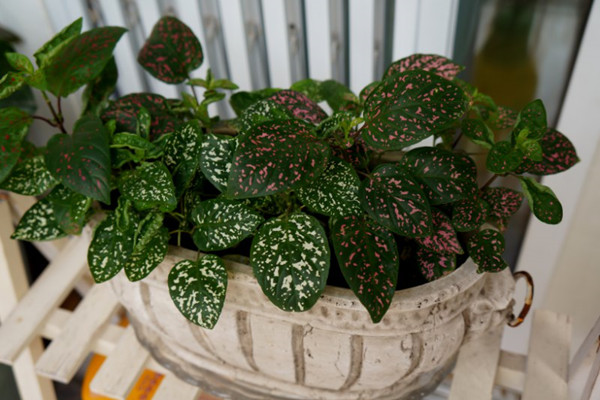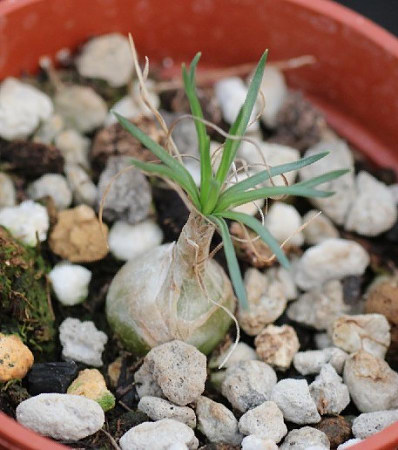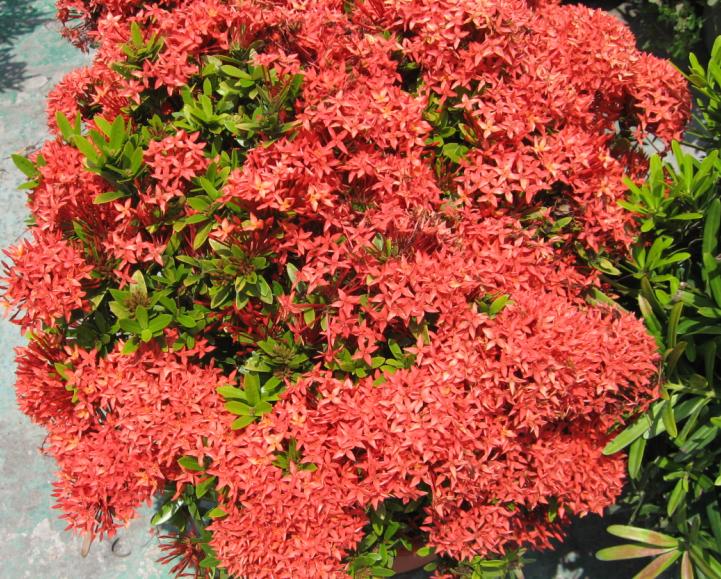Culture methods and matters needing attention of Red spot Grass
Red spot grass called splashing red grass, purplish red vine red spot grass is a plant of the genus hypoestes, native to Madagascar. The height of the plant can reach 60 cm, and the potted plant is about 10 cm to 15 cm. The branches are semi-trailing after elongation, and the stem nodes are easy to root. Leaves opposite, ovate or long ovate, leaf axils easy to give birth to short lateral branches, leaf surface olive green, covered with pink or white spots, very similar to wine spray paint ink, elegant style. Can blossom in spring, the flower color is lilac and inconspicuous, usually with foliage as the main, suitable for garden decoration or small potted plants as indoor plants.
Reproduction: sowing or cutting can be used. The survival rate of cuttage seedlings in South China is high, and it can raise seedlings all the year round, but it is better in spring and autumn, and the suitable temperature for rooting is about 20-25 degrees Celsius. The terminal buds or branches were cut and cut into river sand or culture soil made of river sand, perlite and serpent shavings, keeping cool and humid, and rooting in about 3-4 weeks. Cuttings can also be inserted directly into the potted soil to make it grow, and 3-5 branches can be inserted in every 5-inch pot.

Culture methods of red spot grass the soil of red spot grass
Red spot grass likes loose and breathable, well-drained, deep, fertile, humus-rich, slightly acidic soil.
The temperature of red spot grass
The normal growth temperature of red spot grass is between 15-18 ℃, and the overwintering temperature is above 12 ℃ in winter. Not resistant to severe cold, pay attention to keep warm in winter, put red spot grass indoors, and ensure that the room temperature is above 12 ℃. When the summer temperature is too high, we should pay attention to shading, cooling and ventilation.
Moisture content of Red spot Grass
Red spot grass likes the moist growth environment, in the normal growth period to pay attention to the wettability of the basin soil, should be often watered. Summer temperature is too high, to increase the number of watering, at the same time to spray water to the leaves to enhance the humidity of the air.
The light of red spot grass
Red spot grass likes the warm and humid semi-shady environment, likes the light, but requires partial shade or partial light, the appropriate increase of direct light can make the dead leaves more shiny.
Fertilization of Red spot Grass
Red spot grass for fertilizer demand is not very frequent, only need to apply nitrogen, phosphorus, potassium fertilizer or Taiwan fertilizer quick-acting No. 1 once a month.
Red spot grass is easy to suffer from stem rot in the growing period. It can be irrigated with mixed water of pentachloronitro powder and dimethazone powder, or it can be controlled by carbendazim and methyl trimethoprim.
Attention points for pruning of Red spot Grass
After the red spot grass blossoms, the branches will die with the flowers. It is necessary to cut off the dead branches and promote the roots to grow new branches. When growing too fast, we should pick the heart in time, promote multiple branches and plant dwarfing, and improve the ornamental value. When the lower leaves of the plant are too high and wither, they should be re-pruned.
Replacement of basin soil
When transplanting red spot grass, the original soil should be mixed into the new flowerpot, with half of the new and the old as the best, so as to prevent death from environmental discomfort.
Culture methods of Phalaenopsis Video _ Culture methods and matters needing attention
Phalaenopsis, also known as Phalaenopsis and Taiwan Phalaenopsis, is a kind of flower plant belonging to the genus Butterfly of Orchidaceae. it is native to subtropical rain forest and is a kind of epiphytic orchid. Phalaenopsis white thick air root is exposed around the leaves, it can absorb nutrients in the air, but also can grow to achieve the effect of photosynthesis. During the Spring Festival, Phalaenopsis plants will produce long pedicels from leaf axils, thus forming butterfly orchids dancing like butterflies, which are very popular with people. Butterfly love is mainly distributed in Indonesia, Taiwan, the Philippines, Thailand, Malaysia and other regions, with the reputation of queen of orchids. Next, let's take a look at the Phalaenopsis culture method is video, as well as Phalaenopsis culture methods and points for attention. [Phalaenopsis culture method video]
The name of Phalaenopsis is based on the butterfly-like orchid in ancient Greek. It can help absorb nutrients in the air and survive, and it mainly belongs to the category of aerial orchids. It belongs to a larger family of tropical orchids. Phalaenopsis in Taiwan is famous all over the world, while there are 50 or 60 native species of Phalaenopsis in Indonesia, Borneo, Philippines and Malaysia. The color of Phalaenopsis is rich and colorful, there are white, yellow spots, pink and so on, are very many. According to botanists using precious varieties for artificial cultivation, so as to improve a variety of flower shapes, colors of Phalaenopsis, and in the flower size is also very great achievement. And Phalaenopsis's white, pink, yellow erythema, red dots and red lines, pure yellow, white flowers and red and other colors can be seen, Phalaenopsis can be called after today's orchids, is a delightful flower plant. [growth habits of Phalaenopsis] Phalaenopsis is native to tropical rain forests and likes to grow in a warm environment, but it is afraid of the cold. The suitable temperature for growth is 15-20 degrees Celsius. If the temperature is below 10 degrees Celsius in winter, it will stop growing. The temperature should not be lower than 5 degrees Celsius, or the plant will die. Phalaenopsis, which is native to tropical Malaysia, belongs to Phalaenopsis. Phalaenopsis is a perennial herb, and Phalaenopsis grows luxuriantly along the river coast with high temperature and humidity. However, in the case of high temperature and humidity, Phalaenopsis will be harmful to diseases and insect pests, and the humidity suitable for growing environment is 60-80%. [Phalaenopsis culture methods and points for attention] 1. Soil: the breeding method of Phalaenopsis is mainly sowing and reproduction, and it is an epiphytic orchid whose aerial roots are attached to rocks or tree trunks, mainly absorbing water and nutrients from the air. Phalaenopsis is mainly cultivated with loose and breathable materials, it is best to choose bark, broken bricks, coconut shells, tree fern roots, water moss, etc., using the county party committee or ceramsite as the matrix, the seedlings are directly fixed in charcoal, so that Phalaenopsis grows naturally in the process of growth, and the pH value is 6.5. It is best to use bryophytes and aquatic plants, choose a softer soil is the best. two。 Temperature: Phalaenopsis has relatively strict requirements on temperature. the suitable temperature for growth is 15-30 degrees Celsius during the day and 23 degrees Celsius at night. If it is lower or higher than this temperature, it will be not conducive to the growth of Phalaenopsis. Serious will cause leaves yellowing. Fan water curtain can be used to cool down when the temperature is high, and a heater can be used to increase the temperature when the temperature is low. 3. Humidity: in the vegetative growth stage of Phalaenopsis, the humidity requirement of more than 90% is the best state, and the humidity of promoting flowers should be kept at 70-80%, and the humidity requirement should be 50% after flowering. It is most appropriate to use water curtain ventilation or ground space humidity control measures. 4. Lighting: the proper lighting of Phalaenopsis is the best, it is a shade-loving plant, but it also needs sufficient light to provide energy for itself, especially in the flowering period, Phalaenopsis needs more adequate light to avoid direct sunlight. Phalaenopsis is of very high air quality, so it is best to put it in a ventilated place for breeding, which can effectively prevent the emergence of insect pests. 5. Fertilization: in the spring Phalaenopsis growing period, you can choose to use Phalaenopsis special nutrient solution to fertilize, in winter, if the amount of fertilizer is reduced, it will affect the flowering next year. The withered flowers should be pruned after the couple, which can effectively reduce the consumption of nutrients, so that the withered flowers don't look good hanging from them. 6. Moisture: Phalaenopsis leaves are not easy to store water, so it is necessary to replenish sufficient moisture to the soil. Phalaenopsis new roots should be over-watered when they are growing vigorously, and the amount of water should be reduced when they are dormant after flowering. In spring and autumn, they are watered at about five o'clock every day, while when plants are growing vigorously in summer, they are watered in the morning and afternoon respectively. The temperature in winter is low and the light is relatively weak. Need to water every other week, after the cold wave, do not water too much, to keep the soil dry, so it is not easy to cause the plant to freeze to death. [matters needing attention in Phalaenopsis Culture] Phalaenopsis should be properly watered when breeding butterflies, and the amount of water should not be too frequent, otherwise it will cause the root of Phalaenopsis to rot. Also pay attention to keep warm, the temperature is too low will make Phalaenopsis dormant, especially in winter, we must pay attention to keep warm. Proper fertilization is very rude to the growth of Phalaenopsis. Once a week or so during the growing period, you can choose to apply professional fertilizer. The flowerpot for breeding Phalaenopsis is also very important, and the appropriate large flowerpot is more conducive to the growth of Phalaenopsis.
More information about the efficacy and function of egg yolk fruit Cistanche deserticola what is the role of magnolia Suoyang pictures of Magnolia Magnolia
- Prev

Bulb flowers need to grow balls first when they return to flowers.
The flower bud formation of bulbous flowers is mostly stimulated by temperature difference. Most parts of our country have four distinct seasons of climate, without any stimulation, bulb flowers can be reflowered, that is to say, as long as a good ball, reflowering is sooner or later, a variety of bulbous flowers can be reflowered. So it comes down to-the point is to raise the ball well.
- Next

Culture methods and matters needing attention of Xiandan Flower (Red Hydrangea)
The Xiandan flower is a common Hashimoto flower, which can be found in parks, courtyards or other green spaces. Although the flowers of elixir are not large, they can win by quantity. No matter which variety or color they are, when they are in full bloom, there are only clusters of flowers in the branches, and the leaves are almost submerged in the sea of flowers. Elixir is native to tropical Asia.
Related
- Fuxing push coffee new agricultural production and marketing class: lack of small-scale processing plants
- Jujube rice field leisure farm deep ploughing Yilan for five years to create a space for organic food and play
- Nongyu Farm-A trial of organic papaya for brave women with advanced technology
- Four points for attention in the prevention and control of diseases and insect pests of edible fungi
- How to add nutrient solution to Edible Fungi
- Is there any good way to control edible fungus mites?
- Open Inoculation Technology of Edible Fungi
- Is there any clever way to use fertilizer for edible fungus in winter?
- What agents are used to kill the pathogens of edible fungi in the mushroom shed?
- Rapid drying of Edible Fungi

